Overview
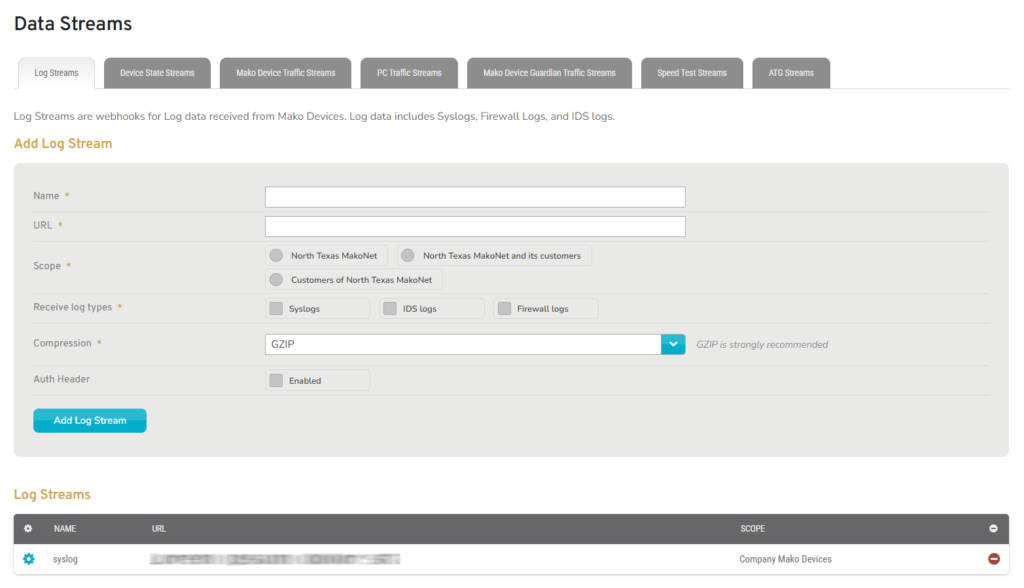
Figure 1. Example Data Streams Page
Mako Networks provides an Application Programming Interface (API) that can be used to integrate the Mako Central Management System (CMS) with external systems, such as data analytics platforms and custom business applications.
A detailed API specification for developers is available by request from Mako Support.
The Data Streams page allows you to manage data stream integrations for the selected company. Data streams push log and state data from the Mako CMS to client application endpoints and are scheduled at regular intervals.
Use the tabs at the top of the page to manage different types of data streams.
- Log Streams
- Device State Streams
- Mako Device Traffic Streams
- PC Traffic Streams
- Mako Device Guardian Traffic Streams
- Speed Test Streams
- ATG Streams
Log Streams
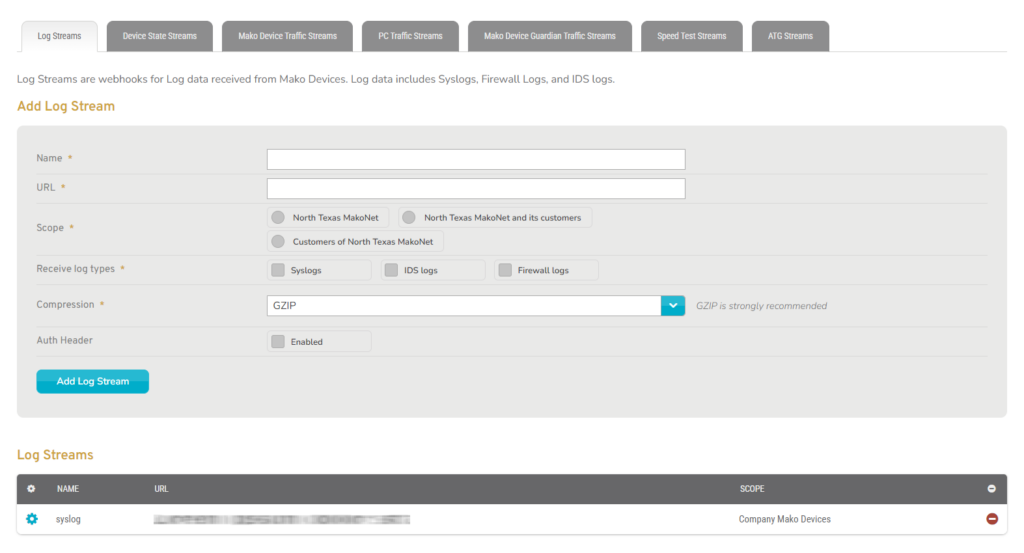
Figure 2. Example Log Streams Tab
The Log Streams tab displays Log data stream integrations for the selected company. The log types available to stream from Mako devices are Syslogs, IDS logs, and Firewall logs.
Add Log Stream
Use the Add Log Stream form to add a new Log data stream integration for the selected company.
Name
Enter an informative, memorable, and unique name for this data stream integration.
URL
Enter the client application endpoint that will receive data from the Mako CMS for this data stream integration.
The functionality at the client application endpoint must be designed to handle the data format provided by the API. Refer to the API specification.
Scope
Choose whether or not this data stream integration will be available to customers of the selected company.
Log Types
Choose which types of log data to receive at the endpoint for this data stream integration. The log types available are Syslogs, IDS logs, and Firewall logs.
Compression
Choose whether this data stream integration should use GZIP compression to reduce the size of HTTP data transmissions.
GZIP compression is strongly recommended.
Auth Header
Enable this feature if the client application endpoint requires a specific header on all requests. This can be used as an added security measure to identify legitimate pushes from the API, helping to protect the client application from illegitimate activity.
The functionality at the client application endpoint must be designed to require the appropriate header name and value for this feature to function properly.
Auth Header Name
Enter the unique name for the Auth Header. This is required if Auth Header is enabled.
Auth Header Value
Enter the corresponding value for the Auth Header. This is required if Auth Header is enabled.
Add Button
Click the “Add Log Stream” button to create a new data stream integration with these settings.
View Log Streams
Use the Log Streams list to view and manage Log data stream integrations for the selected company.
Columns
- [Edit] – edit icon button
- Name – name of this data stream integration
- URL – client application endpoint for this data stream integration
- Scope – which companies can access this data stream integration
- [Delete] – delete icon button
Actions
Edit Log Stream
Click an existing Log data stream item’s plus icon button to edit the data stream item. Make and save any desired changes using the Edit Log Stream form.
Send Test Request
Click the “Send Test Request” button on the Edit Log Stream form to push test data to the client application endpoint. This can help you troubleshoot the data stream integration.
Delete Log Stream
Click an existing Log data stream’s minus icon button to delete the data stream item. You will be asked to confirm this action.
Device State Streams
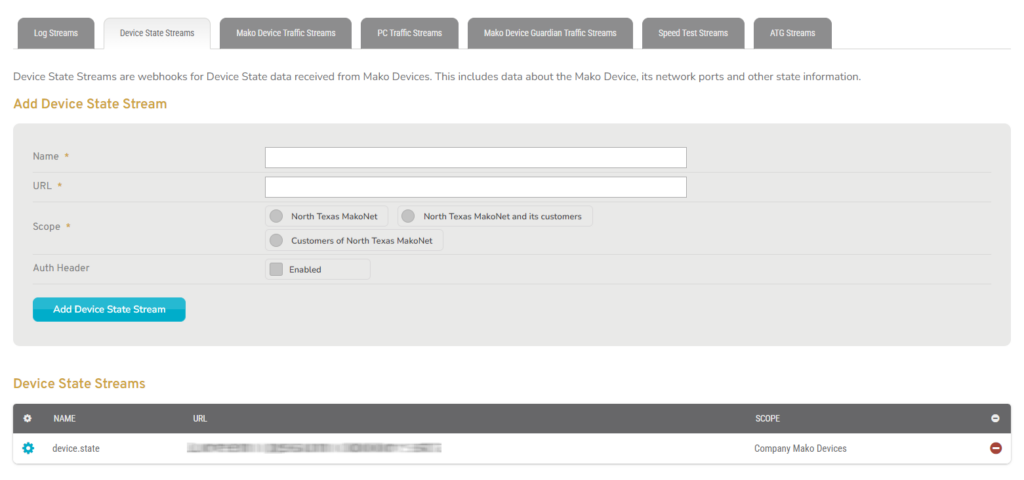
Figure 3. Example Device State Streams Tab
The Device State Streams tab displays Device State data stream integrations for the selected company. Mako devices can provide state data pertaining to device status, network port status, and more.
Add Device State Stream
Use the Add Device State Stream form to add a new Device State data stream integration for the selected company.
Name
Enter an informative, memorable, and unique name for this data stream integration.
URL
Enter the client application endpoint that will receive data from the Mako CMS for this data stream integration.
The functionality at the client application endpoint must be designed to handle the data format provided by the API. Refer to the API specification.
Scope
Choose whether or not this data stream integration will be available to customers of the selected company.
Auth Header
Enable this feature if the client application endpoint requires a specific header on all requests. This can be used as an added security measure to identify legitimate pushes from the API, helping to protect the client application from illegitimate activity.
The functionality at the client application endpoint must be designed to require the appropriate header name and value for this feature to function properly.
Auth Header Name
Enter the unique name for the Auth Header. This is required if Auth Header is enabled.
Auth Header Value
Enter the corresponding value for the Auth Header. This is required if Auth Header is enabled.
Add Button
Click the “Add Device State Stream” button to create a new data stream integration with these settings.
View Device State Streams
Use the Device State Streams list to view and manage Device State data stream integrations for the selected company.
Columns
- [Edit] – edit icon button
- Name – name of this data stream integration
- URL – client application endpoint for this data stream integration
- Scope – which companies can access this data stream integration
- [Delete] – delete icon button
Actions
Edit Device State Stream
Click an existing Device State data stream item’s plus icon button to edit the data stream item. Make and save any desired changes using the Edit Device State Stream form.
Send Test Request
Click the “Send Test Request” button on the Edit Device State Stream form to push test data to the client application endpoint. This can help you troubleshoot the data stream integration.
Delete Device State Stream
Click an existing Device State data stream’s minus icon button to delete the data stream item. You will be asked to confirm this action.
Mako Device Traffic Streams
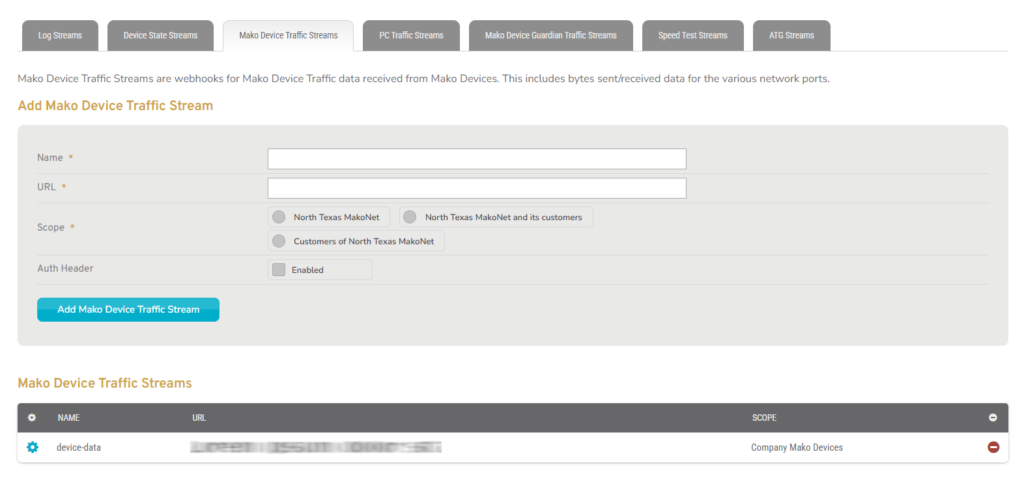
Figure 4. Example Mako Device Traffic Streams Tab
The Mako Device Traffic Streams tab displays Mako Device Traffic data stream integrations for the selected company. Mako devices can provide traffic data, such as bytes sent/received for each network port.
Add Mako Device Traffic Stream
Use the Add Mako Device Traffic Stream form to add a new Mako Device Traffic data stream integration for the selected company.
Name
Enter an informative, memorable, and unique name for this data stream integration.
URL
Enter the client application endpoint that will receive data from the Mako CMS for this data stream integration.
The functionality at the client application endpoint must be designed to handle the data format provided by the API. Refer to the API specification.
Scope
Choose whether or not this data stream integration will be available to customers of the selected company.
Auth Header
Enable this feature if the client application endpoint requires a specific header on all requests. This can be used as an added security measure to identify legitimate pushes from the API, helping to protect the client application from illegitimate activity.
The functionality at the client application endpoint must be designed to require the appropriate header name and value for this feature to function properly.
Auth Header Name
Enter the unique name for the Auth Header. This is required if Auth Header is enabled.
Auth Header Value
Enter the corresponding value for the Auth Header. This is required if Auth Header is enabled.
Add Button
Click the “Add Mako Device Traffic Stream” button to create a new data stream integration with these settings.
View Mako Device Traffic Streams
Use the Mako Device Traffic Streams list to view and manage Mako Device Traffic data stream integrations for the selected company.
Columns
- [Edit] – edit icon button
- Name – name of this data stream integration
- URL – client application endpoint for this data stream integration
- Scope – which companies can access this data stream integration
- [Delete] – delete icon button
Actions
Edit Mako Device Traffic Stream
Click an existing Mako Device Traffic data stream item’s plus icon button to edit the data stream item. Make and save any desired changes using the Edit Mako Device Traffic Stream form.
Send Test Request
Click the “Send Test Request” button on the Edit Mako Device Traffic Stream form to push test data to the client application endpoint. This can help you troubleshoot the data stream integration.
Delete Mako Device Traffic Stream
Click an existing Mako Device Traffic data stream’s minus icon button to delete the data stream item. You will be asked to confirm this action.
PC Traffic Streams

Figure 5. Example PC Traffic Streams Tab
The PC Traffic Streams tab displays PC Traffic data stream integrations for the selected company. Mako devices can provide traffic data from connected devices, such as PCs.
Add PC Traffic Stream
Use the Add PC Traffic Stream form to add a new PC Traffic data stream integration for the selected company.
Name
Enter an informative, memorable, and unique name for this data stream integration.
URL
Enter the client application endpoint that will receive data from the Mako CMS for this data stream integration.
The functionality at the client application endpoint must be designed to handle the data format provided by the API. Refer to the API specification.
Scope
Choose whether or not this data stream integration will be available to customers of the selected company.
Auth Header
Enable this feature if the client application endpoint requires a specific header on all requests. This can be used as an added security measure to identify legitimate pushes from the API, helping to protect the client application from illegitimate activity.
The functionality at the client application endpoint must be designed to require the appropriate header name and value for this feature to function properly.
Auth Header Name
Enter the unique name for the Auth Header. This is required if Auth Header is enabled.
Auth Header Value
Enter the corresponding value for the Auth Header. This is required if Auth Header is enabled.
Add Button
Click the “Add PC Traffic Stream” button to create a new data stream integration with these settings.
View PC Traffic Streams
Use the PC Traffic Streams list to view and manage PC Traffic data stream integrations for the selected company.
Columns
- [Edit] – edit icon button
- Name – name of this data stream integration
- URL – client application endpoint for this data stream integration
- Scope – which companies can access this data stream integration
- [Delete] – delete icon button
Actions
Edit PC Traffic Stream
Click an existing PC Traffic data stream item’s plus icon button to edit the data stream item. Make and save any desired changes using the Edit PC Traffic Stream form.
Send Test Request
Click the “Send Test Request” button on the Edit PC Traffic Stream form to push test data to the client application endpoint. This can help you troubleshoot the data stream integration.
Delete PC Traffic Stream
Click an existing PC Traffic data stream’s minus icon button to delete the data stream item. You will be asked to confirm this action.
Mako Device Guardian Traffic Streams
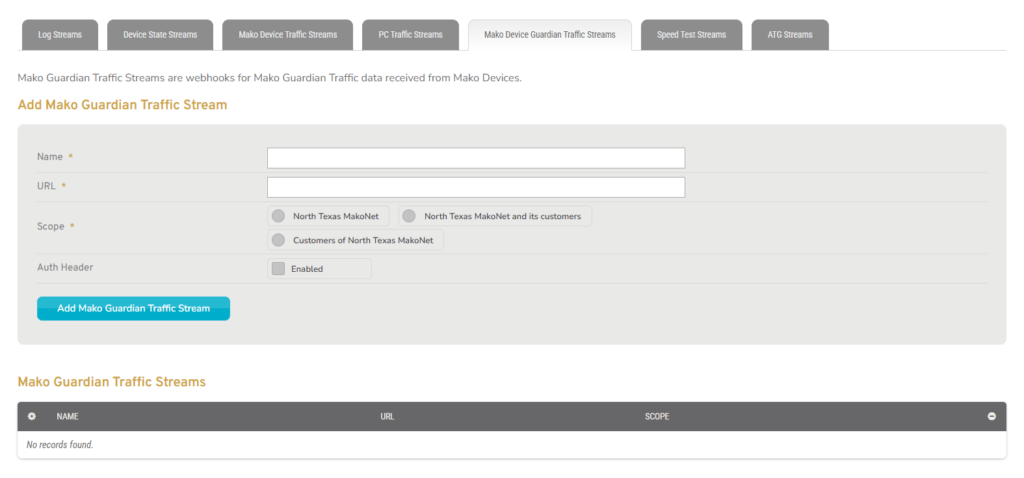
Figure 6. Example Mako Device Guardian Traffic Streams Tab
The Mako Device Guardian Traffic Streams tab displays Mako Guardian Traffic data stream integrations for the selected company. Mako devices can provide traffic data from Mako Guardian content filtering.
Add Mako Guardian Traffic Stream
Use the Add Mako Guardian Traffic Stream form to add a new Mako Guardian Traffic data stream integration for the selected company.
Name
Enter an informative, memorable, and unique name for this data stream integration.
URL
Enter the client application endpoint that will receive data from the Mako CMS for this data stream integration.
The functionality at the client application endpoint must be designed to handle the data format provided by the API. Refer to the API specification.
Scope
Choose whether or not this data stream integration will be available to customers of the selected company.
Auth Header
Enable this feature if the client application endpoint requires a specific header on all requests. This can be used as an added security measure to identify legitimate pushes from the API, helping to protect the client application from illegitimate activity.
The functionality at the client application endpoint must be designed to require the appropriate header name and value for this feature to function properly.
Auth Header Name
Enter the unique name for the Auth Header. This is required if Auth Header is enabled.
Auth Header Value
Enter the corresponding value for the Auth Header. This is required if Auth Header is enabled.
Add Button
Click the “Add Mako Guardian Traffic Stream” button to create a new data stream integration with these settings.
View Mako Guardian Traffic Streams
Use the Mako Guardian Traffic Streams list to view and manage Mako Guardian Traffic data stream integrations for the selected company.
Columns
- [Edit] – edit icon button
- Name – name of this data stream integration
- URL – client application endpoint for this data stream integration
- Scope – which companies can access this data stream integration
- [Delete] – delete icon button
Actions
Edit Mako Guardian Traffic Stream
Click an existing Mako Guardian Traffic data stream item’s plus icon button to edit the data stream item. Make and save any desired changes using the Edit Mako Guardian Traffic Stream form.
Send Test Request
Click the “Send Test Request” button on the Edit Mako Guardian Traffic Stream form to push test data to the client application endpoint. This can help you troubleshoot the data stream integration.
Delete Mako Guardian Traffic Stream
Click an existing Mako Guardian Traffic data stream’s minus icon button to delete the data stream item. You will be asked to confirm this action.
Speed Test Streams

Figure 7. Example Speed Test Streams Tab
If Speed Testing is enabled, the Speed Test Streams tab displays Speed Test data stream integrations for the selected company. To learn more about Speed Testing and to configure testing schedules, see the Speed Test Groups documentation.
Add Speed Test Stream

Figure 8. Example Add Speed Test Stream Form
To add a new Speed Test data stream integration for the selected company, click the “Add Speed Test Stream” button. This will open the Add Speed Test Stream form.
Name
Enter an informative, memorable, and unique name for this data stream integration.
URL
Enter the client application endpoint that will receive data from the Mako CMS for this data stream integration.
The functionality at the client application endpoint must be designed to handle the data format provided by the API. Refer to the API specification.
Scope
Choose whether or not this data stream integration will be available to customers of the selected company.
Auth Header
Enable this feature if the client application endpoint requires a specific header on all requests. This can be used as an added security measure to identify legitimate pushes from the API, helping to protect the client application from illegitimate activity.
The functionality at the client application endpoint must be designed to require the appropriate header name and value for this feature to function properly.
Auth Header Name
Enter the unique name for the Auth Header. This is required if Auth Header is enabled.
Auth Header Value
Enter the corresponding value for the Auth Header. This is required if Auth Header is enabled.
Save Button
Click the “Save Stream” button to create a new data stream integration with these settings.
View Speed Test Streams
Use the Speed Test Streams list to view and manage Speed Test data stream integrations for the selected company.
Columns
- [Edit] – edit icon button
- Name – name of this data stream integration
- URL – client application endpoint for this data stream integration
- Scope – which companies can access this data stream integration
- [Delete] – delete icon button
Actions
Edit Speed Test Stream
Click an existing Speed Test data stream item’s plus icon button to edit the data stream item. Make and save any desired changes using the Edit Speed Test Stream form.
Delete Speed Test Stream
Click an existing Speed Test data stream’s minus icon button to delete the data stream item. You will be asked to confirm this action.
ATG Streams

Figure 9. Example ATG Streams Tab
If SmartATG monitoring is enabled, the ATG Streams tab displays ATG data stream integrations for the selected company. To learn more about ATG monitoring and to configure Polling Frequency for ATG data streams, see the SmartATG documentation.
Visit the Company SmartATG page to manage ATG monitoring settings for the selected company and configure multiple sites at once.
Visit the Site SmartATG page to manage ATG monitoring settings for the selected site.
Add ATG Stream

Figure 10. Example Add ATG Stream Form
To add a new ATG data stream integration for the selected company, click the “Add ATG Stream” button. This will open the Add ATG Stream form.
Name
Enter an informative, memorable, and unique name for this data stream integration.
URL
Enter the client application endpoint that will receive data from the Mako CMS for this data stream integration.
The functionality at the client application endpoint must be designed to handle the data format provided by the API. Refer to the API specification.
Scope
Choose whether or not this data stream integration will be available to customers of the selected company.
Auth Header
Enable this feature if the client application endpoint requires a specific header on all requests. This can be used as an added security measure to identify legitimate pushes from the API, helping to protect the client application from illegitimate activity.
The functionality at the client application endpoint must be designed to require the appropriate header name and value for this feature to function properly.
Auth Header Name
Enter the unique name for the Auth Header. This is required if Auth Header is enabled.
Auth Header Value
Enter the corresponding value for the Auth Header. This is required if Auth Header is enabled.
Save Button
Click the “Save Stream” button to create a new data stream integration with these settings.
View ATG Streams
Use the ATG Streams list to view and manage ATG data stream integrations for the selected company.
Columns
- [Edit] – edit icon button
- Name – name of this data stream integration
- URL – client application endpoint for this data stream integration
- Scope – which companies can access this data stream integration
- [Delete] – delete icon button
Actions
Edit ATG Stream
Click an existing ATG data stream item’s plus icon button to edit the data stream item. Make and save any desired changes using the Edit ATG Stream form.
Delete ATG Stream
Click an existing ATG data stream’s minus icon button to delete the data stream item. You will be asked to confirm this action.
